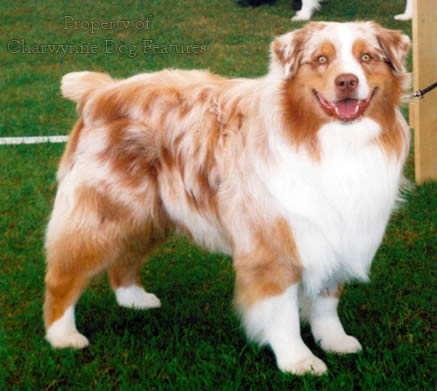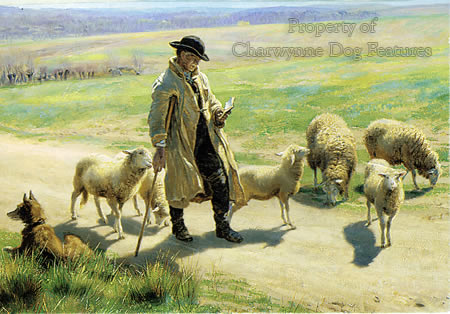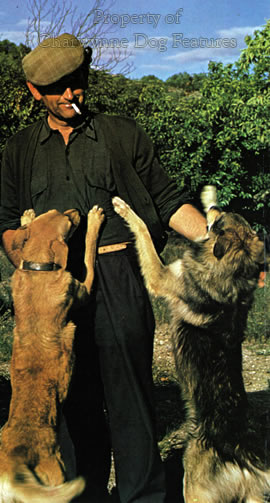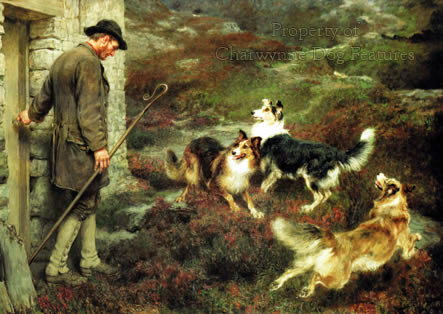484 THE FUTURE OF THE SHEPHERDS
THE FUTURE OF THE SHEPHERDS' DOGS
by David Hancock
 The Future of the Working Dog
The Future of the Working Dog
“The townsman who knows the shepherd’s dog only as he is to be seen, out of his true element, threading his confined way through crowded streets where sheep are not, can have small appreciation of his wisdom and his sterling worth. To know him properly, one needs to see him at work in a country where sheep abound, to watch him adroitly rounding up his scattered charges on a wide-stretching moorland, gathering the wandering wethers into close order and driving them before him in unbroken company to the fold; handling the stubborn flock in a narrow lane, or holding them in a corner of a field, immobile under the spell of his vigilant eye. He is at his best as a worker, conscious of the responsibility reposed in him; a marvel of generalship, gentle, judicious, slow to anger, quick to action; the priceless helpmeet of his master – the most useful member of all the tribe of dogs.”
From The Complete Book of the Dog by Robert Leightonof 1922.
Remarkable Span
The dogs of the shepherds have profoundly influenced the use of dogs to support the activities of modern man, whether in the detection of banned substances or explosive devices, the support of disabled people who are deaf, blind or susceptible to illnesses such as diabetic comas or in locating missing persons on remote hillsides. They provide companionship to lonely individuals across the developed world. They are quick to learn and eager to serve. They have influenced the companion dog scene right across the globe, with the beardie type perhaps providing the common dog of Europe from the Iberian Peninsula in the West to Hungary in the East, and the flock guardian type protecting man’s interests for centuries across the same span. Imposing breeds like the Tornjak of Croatia, the Central Asian Owtcharka, the Greek Sheepdog and the Transmontana Mastiff of Portugal must never be allowed to become extinct through our neglect. They may lack the glamour of the more fashionable breeds and the weight of words lavished on the sporting breeds, but they have supported man for longer and in more extreme conditions than any other type of dog. They have proved themselves as the ultimate in animal companions for man – and many of them still work with sheep! We owe them a secure future.
Surveying the Field
If you wish to have a quick ‘snapshot’ view of the state of the pastoral and working breeds of dog in Britain, then a visit to a championship dog show when these breeds are on display, is a good choice. The Bath Dog Show, held on a superb site, truly pastoral, for such dogs, on ‘Pastoral and Working Breeds Day’, in May 2013, gave me such an insight. The immediate impression was that the exotic breeds were there in greater numbers than our native ones. There were, not surprisingly, plenty of Rough Collies (128 entered), Bearded Collies (124), Shetland Sheepdogs (103) and Border Collies (82). But there were more Belgian Shepherd Dogs (86 of all the breeds covered by this title) than Old English Sheepdogs (52), more Finnish Lapphunds (26) than our own Smooth Collies (18), and more Pyrenean Mountain Dogs (34), Briards (16), Estrela Mountain Dogs (18) and Hungarian Pulis (23) than our own Lancashire Heeler (9) and Cardiganshire Welsh Corgis (14). Such a survey is much more visible than say registration figures with the KC and made a stark contrast with my memories of this show sixty years ago, (as a teenaged kennel-boy to the vet for this show, I was able to tour the annual shows with him, benefiting from his running commentary on the entry before us), when breeds from overseas were rare and our own breeds well supported. I welcome the foreign pastoral breeds but am concerned for our native ones. I was concerned too about the unsound physique of far too many of the entry. Over the years, I have attended seven World Dog Shows, innumerable championship shows, a wide variety of dog events, here and overseas; I see more unsound dogs now than ever before; in the show ring they look more glamorous and are more exhibitionist than the working dogs, but sound they are not.
Seeking Soundness
Studying this entry brought home to me how the general public regards the purebred dog as an emblem of good breeding, with the strange reverence for the pedigree prevailing. I expect to find truly functional dogs at a show with this collection of breeds; I am doubly disappointed to find unsound dogs on such a day. Taking time to study and then examine just a few of our native breeds gave a distinct impression of unsound front construction, poor movement, soft muscle and vision impaired by facial hair. These exhibits were mostly between one and seven years of age; when they were being bred the judges were already commenting on shortcomings in the breeds concerned. From 2008 to 2012, the critiques of championship show judges bemoaned the small eyes, weak jaws, thin muzzles, poor front movement, upright shoulders and short upper arms in Collies; short upper arms, lack of muscle tone, and exaggerated hind-angulation in Beardies; dreadful and appalling movement, steep/straight upper arms, lack of muscle tone and a lack of drive on the move in Shelties; poor movement, weak hocks, being blindfolded by hair over the face, poor muscle tone and difficulty in locating the eyes in Bobtails. Faults and flaws in these native breeds are simply not being addressed. This is very bad news for the breeds concerned, as well as future owners.
Breeding for Quality
It is a sad fact that most dog breeders breed on the phenotype, i.e. what the parents look like, rather than the genotype, i.e. what genes are able to be passed on. Breeding living creatures can only ever be an exercise in genetics and breeders seeking to establish a line of consistent type must accept that every dog and bitch mating is a blending of two families not just of a sire and a dam. The phrase that seems to lead to mistaken assumptions is the one that states that a puppy gets 50% of its genes from the sire and 50% from the dam. A better, more accurate, more valuable phrase is that a puppy gets 50% of its genes through its sire and 50% of its genes through its dam. That is why it is simply vital to know what stock is behind the parents of the puppy.
Breeding pedigree dogs is made more risky in Britain by the lack of reliable records. It is automatically assumed that the written pedigree is accurate whereas an alarming proportion of them are not. No dog has to be individually and irrevocably made identifiable by way of a tattoo or microchip. Judges in the show ring and owners of bitches only have someone's word that the dog before them in the ring or the sire being used for the service is the one named on the pedigree or put forward as such. It only needs one prolific breeder to be dishonest for the whole breeding record of a pedigree breed to be made unreliable. The written pedigree too is restricted to number, gender, colour and breed; there is no record of the strengths or faults of the dog on its pedigree despite show critiques containing detailed comment being available after every major show.
Need for Health Checks
In Britain there are no unavoidable mandatory health checks on breeding stock, unlike the vast majority of other countries in which the pedigree dog is looked after by a kennel club. Health checks of course will never represent a 100% assurance of clear stock, a guarantee of faults being present or not, or be an indication of quality by themselves. There are bitches with worryingly high hip scores that regularly produce progeny with low hip scores. There is however no data on the hip health of the next generation from such dogs. No sensible breeder seeks dogs with perfect hips and eyes but lacking breed type or soundness of construction. But dog breeders should have access to sufficient data to enable them to make a balanced judgement. No humane person wants to produce dogs with a built-in likelihood of future lameness, blindness or deafness. But until quite recently no truly realistic attempts, on a proper scientific system, were being made nationally to seek a reduction in the chance of unhealthy or crippled dogs being bred. In 2013, the KC Genetics Centre at the Animal Health Trust began detailed studies into 38 breeds, for the better understanding of the genetic structure and inherited diseases in all dogs. At last!
Beardie Initiative
I give praise to The Southern Counties Bearded Collie Club for their foresight and moral leadership in establishing their Hip Scoring Scheme long before the KC/ BVA Scheme switched entirely to Hip Scoring of all breeds. This visionary club set up a Special Open Class at their breed club shows for dogs Certified Clear of Hip Dysplasia or with a Breeders Letter under the old scheme or within a certain score range under the Scoring Scheme. This forward-looking action played a valuable role in getting owners to X-ray their dogs and publish the results. The wider scheme across the breed was also subsidized by the clubs in a praiseworthy campaign. I would like to see the Corgi breed clubs emulate the Dachshund and Basset Hound Breed Councils by responding to the research published by the Royal Veterinary College in 2013, that stated that dogs with longer backs relative to their legs are more in danger of suffering from intervertebral disc disease. If the exaggeration in the length of back and shortness of leg in Corgis continues unchecked, many dogs will suffer from painful and debilitating slipped discs. This is avoidable. 
Healthy Breeding
A 2013 study at the University of California Veterinary Teaching Hospital used medical records from 27,000 dogs over 15 years to study 24 known genetic disorders in dogs such as cancer, dysplasia, cardiac problems, patellar luxation and epilepsy. Analysis indicated that ‘genetic disorders were individual in their expression throughout the dog population’ and that ‘some genetic disorders were present with equal prevalence among all dogs in the study, regardless of purebred or mixed-breed status’. The show world immediately took this to prove that purebred dogs were no less healthy than crossbred ones; but which breeds contributed to the mix? This study actually found that ten of the disorders under scrutiny were more prominent in purebred dogs. These were aortic stenosis, dilated cardiomyopathy, hypothyroidism, elbow dysplasia, intervertebral disc disease, atopy, dermatitis, bloat, cataracts, epilepsy and shunt. Fourth highest in intervertebral disc disease was the Pembroke Welsh Corgi; first in the elbow dysplasia category came the Bernese Mountain Dog, with the Anatolian Shepherd Dog in fifth highest. Mixed breeds showed the highest percentages affected by cruciate ligament ruptures, perhaps from the unwise crossing of two breeds with very different skeletal structures. The lesson from such a study is that breeding stock must be screened for those disorders where screening is possible.
Genetic Defects
If you consult authoritative books like Gough and Thomas’s Breed Predispositions to Disease in Dogs and Cats (Blackwell, 2004) and Clark and Stainer’s Genetic Aspects of Pure-bred Dogs (Forum Publications, 1994), you can soon discern the worrying threat to the well-being of our pastoral and working breeds from faulty genes. In the Australian breeds, the cattle dog has recognized ophthalmic problems such as cataracts, lens luxations and progressive retinal atrophy, with congenital portosystemic encephalopathy most common in this breed. Hereditary cerebellar abiotrophy has been diagnosed in Kelpies. A number of different eye problems have been reported in Australian Shepherds, together with hereditary deafness associated with the merle, piebald or extreme piebald genes. Rough Collies can suffer from dentition problems arising from too narrow a bottom jaw, micropthalmia from having small eyes and many veterinary dermatologists find the breed very susceptible to demodicosis, hydradivitis and nasal pyoderma, linking this with the heavy coat. The Bearded Collie has a low incidence of hereditary and congenital defects, although certain bloodlines produce dogs with a form of epilepsy. Breeders of Malinois have reported a high incidence of neoplasia; hypothroid is of concern in the Tervueren and epilepsy has been reported but the breed is relatively free of hip dysplasia. The Shetland Sheepdog has the longest list of hereditary defects, with the breed having its own form of disproportionate dwarfism, often found when the parents themselves are unaffected. This list, across these breeds, sounds daunting but the pastoral and working breeds suffer the least from such flawed genes.
One of the difficulties facing breeders of live animals, whether it’s dogs or parakeets, is that professional scientists have made genetics a foreign language. The role of the expert surely is to make a complex subject more easily understood. Scientists are not good at this and yet display impatience when their work is misunderstood or not heeded. Dog breeders know too that there has never been a geneticist among the most successful of them. Geneticists are scientific advisors and breeding is an art as well as a science. They can advise us on how diseases that are inheritable are passed on. They can advise us on how physical and mental characteristics are likely to be passed on. But in the end the skill of the breeder lies in selection, the selection of breeding stock, the selection of parents and the selection of a breeding path to follow.
Selection of Breeding Stock
Selection based on the mere fact that the dam is a nice pet and ought to be bred from, or has won a couple of prizes and her pups will bring in income, or the future chosen sire is a current big winner, contributes little to a breed and even less to the reputation of the breeder concerned. No bitch should be bred from just because she is female and fertile. Puppies should, in the genuine dog-lover's world, never be produced to suit someone's bank balance; there are already too many unwanted and ill-kept dogs in Britain. For any breeder to mate his precious bitch to a dog just because the dog is currently winning well is sheer folly. It assumes that the judges rewarding the sire are knowledgeable and unbiased - but are they? And even if the sire to be is a worthy champion, what family does he come from? The genes of his ancestors will come through him.
Until we have better data from approved national schemes, selection of breeding stock will rely on the researching skills of each individual breeder. With the accuracy of the written pedigree never being checked by the Kennel Club, just the breeder's word accepted, with no mandatory health clearances, no national dog identification scheme and no information of breeding value on the written pedigree, coupled with untrained judges rewarding unworthy dogs, any breeder faces an uphill battle in the pursuit of breeding better dogs. The appointment of a geneticist for each breed and the appointment of a breed archivist to verify pedigrees, together with a grading system to establish just how good each dog is, would help enormously. Sire ranking lists are available to livestock breeders but not yet to dog breeders - how long can that continue? It is just not good enough to rate a sire by how many champions he has sired; who is testing his offspring for genetic quality?
Novice breeders may well despair of finding the essential data on which to base their breeding programme. Veteran breeders usually know that dogs bearing this particular affix display certain good qualities, whilst those bearing another one feature other complementary ones. Shrewd breeders usually utilize an older stud dog, his track record can at least be examined. There is financial sense in a small breeder not kenneling his own stud dog but using outside blood to a well-researched plan. Long established kennels in every breed often develop their own kennel signature or kennel type. When this conforms precisely to the breed standard, it provides valuable stable genetic material. But when one influential breeder is producing untypical stock, however attractive or successful, it is most important for the novice breeder to detect this. In the end, the breed standard is the breeding blueprint, a design for the future product. Knowledge of it and more important still, an understanding of it, is essential for the successful breeding to type in a pure-bred breed of dog. Of all the breeds of dog in the world, it could be argued that the dogs of the shepherds, so widely used in modern society, have served us the best. Their future needs, and deserves, our very best custodianship.